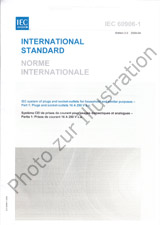Wir benötigen Ihre Einwilligung zur Verwendung der einzelnen Daten, damit Sie unter anderem Informationen zu Ihren Interessen einsehen können. Klicken Sie auf "OK", um Ihre Zustimmung zu erteilen.

IEC/TR 61850-7-6-ed.2.0
Communication networks and systems for power utility automation - Part 7-6: Guideline for definition of Basic Application Profiles (BAPs) using IEC 61850
Name übersetzen
NORM herausgegeben am 6.12.2024
Informationen über die Norm:
Bezeichnung normen: IEC/TR 61850-7-6-ed.2.0
Ausgabedatum normen: 6.12.2024
SKU: NS-1207600
Zahl der Seiten: 144
Gewicht ca.: 463 g (1.02 Pfund)
Land: Internationale technische Norm
Kategorie: Technische Normen IEC
Kategorie - ähnliche Normen:
Die Annotation des Normtextes IEC/TR 61850-7-6-ed.2.0 :
IEC TR 61850-7-6:2024, which is a Technical Report, is focused on building application / function profiles and specifies a methodology to define Basic Application Profiles (BAPs), in textual documents (edition 1, 2019) or in a machine processable SCL format (current edition). These Basic Application Profiles provide a framework for interoperable interaction within or between typical substation automation functions. BAPs are intended to define a subset of features of IEC 61850 in order to facilitate interoperability in a modular way in practical applications. It is the intention of this document to provide a common and generic way to describe the functional behavior of a specific application function in the domain of power utility automation systems as a common denominator of various possible interpretations/implementations of using IEC 61850. The guidelines in this document are based on the functional definitions of: • IEC 61850-5, Communication requirements for functions and device models, which gives a comprehensive overview of all application functions needed in a state-of-the-art substation automation implementation. • IEC TR 61850-7-500, Basic information and communication structure – Use of logical nodes for modelling application functions and related concepts and guidelines for substations, which illustrates and explains application functions for the substation/protection domain of Logical Nodes in modelling simple and complex functions, to improve common understanding in modelling and data exchange, and finally to lead to interoperable implementations. • IEC TR 61850-90-3, Using IEC 61850 for condition monitoring diagnosis and analysis, which gives use cases and data modelling for condition monitoring diagnosis and analysis functions for substation and power grid facilities. • IEC TR 61850-90-30, IEC 61850 Function Modelling in SCL, which describes extensions of the SCL Substation/Process Section allowing to create a comprehensive, IED and hardware independent specification of an IEC 61850 based power system. This document does not describe the applications and respective implementation requirements; the focus is on their typical information exchange including data and communication services and engineering conventions. This second edition cancels and replaces the first edition published in 2019. This edition constitutes a technical revision. This edition includes the following significant technical changes with respect to the previous edition: a) New Clause 5 added to describe the way to express Basic Application Profile in SCL files; b) New Annex F and Annex G added to list specific use cases and roles of the Concept Definition Tool.
Empfehlungen:
Aktualisierung der technischen Normen
Wollen Sie sich sicher sein, dass Sie nur die gültigen technischen Normen verwenden?
Wir bieten Ihnen eine Lösung, die Ihnen eine Monatsübersicht über die Aktualität der von Ihnen angewandten Normen sicher stellt.
Brauchen Sie mehr Informationen? Sehen Sie sich diese Seite an.



 Cookies
Cookies
